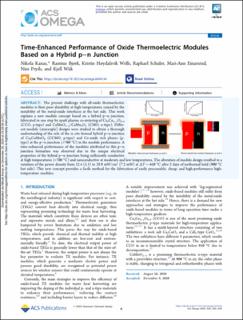| dc.contributor.author | Kanas, Nikola | |
| dc.contributor.author | Bjørk, Rasmus | |
| dc.contributor.author | Wells, Kristin Høydalsvik | |
| dc.contributor.author | Schuler, Raphael | |
| dc.contributor.author | Einarsrud, Mari-Ann | |
| dc.contributor.author | Pryds, Nini | |
| dc.contributor.author | Wiik, Kjell | |
| dc.date.accessioned | 2022-03-08T08:18:28Z | |
| dc.date.available | 2022-03-08T08:18:28Z | |
| dc.date.created | 2021-01-19T14:45:07Z | |
| dc.date.issued | 2021 | |
| dc.identifier.citation | ACS Omega. 2021, 6 197-205. | en_US |
| dc.identifier.issn | 2470-1343 | |
| dc.identifier.uri | https://hdl.handle.net/11250/2983626 | |
| dc.description.abstract | The present challenge with all-oxide thermoelectric modules is their poor durability at high temperatures caused by the instability of the metal-oxide interfaces at the hot side. This work explains a new module concept based on a hybrid p–n junction, fabricated in one step by spark plasma co-sintering of Ca3Co4–xO9+δ (CCO, p-type) and CaMnO3−δ/CaMn2O4 (CMO, n-type). Different module (unicouple) designs were studied to obtain a thorough understanding of the role of the in situ formed hybrid p–n junction of Ca3CoMnO6 (CCMO, p-type) and Co-oxide rich phases (p-type) at the p–n junction (>700 °C) in the module performance. A time-enhanced performance of the modules attributed to this p–n junction formation was observed due to the unique electrical properties of the hybrid p–n junction being sufficiently conductive at high temperatures (>700 °C) and nonconductive at moderate and low temperatures. The alteration of module design resulted in a variation of the power density from 12.4 (3.1) to 28.9 mW/cm2 (7.2 mW) at ΔT ∼ 650 °C after 2 days of isothermal hold (900 °C hot side). This new concept provides a facile method for the fabrication of easily processable, cheap, and high-performance high-temperature modules. | en_US |
| dc.language.iso | eng | en_US |
| dc.publisher | American Chemical Society | en_US |
| dc.rights | Navngivelse 4.0 Internasjonal | * |
| dc.rights.uri | http://creativecommons.org/licenses/by/4.0/deed.no | * |
| dc.title | Time-enhanced performance of oxide thermoelectric modules based on a hybrid p-n junction | en_US |
| dc.type | Peer reviewed | en_US |
| dc.type | Journal article | en_US |
| dc.description.version | publishedVersion | en_US |
| dc.source.pagenumber | 197-205 | en_US |
| dc.source.volume | 6 | en_US |
| dc.source.journal | ACS Omega | en_US |
| dc.identifier.doi | 10.1021/acsomega.0c04134 | |
| dc.identifier.cristin | 1874503 | |
| dc.relation.project | Norges forskningsråd: 228854 | en_US |
| cristin.ispublished | true | |
| cristin.fulltext | original | |
| cristin.qualitycode | 1 | |

